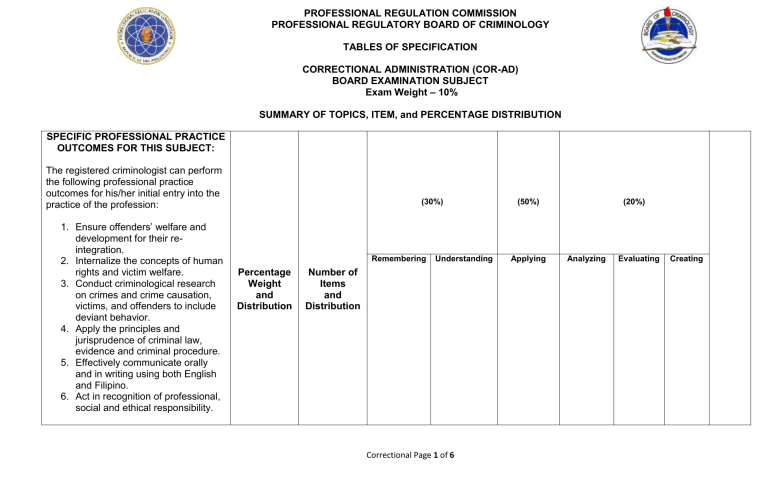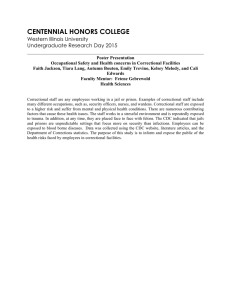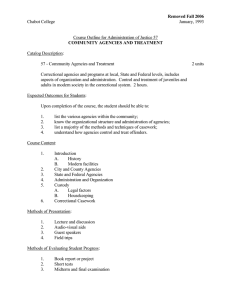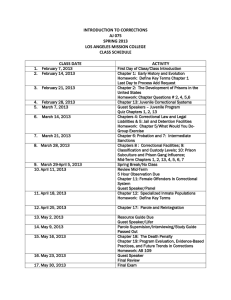
PROFESSIONAL REGULATION COMMISSION PROFESSIONAL REGULATORY BOARD OF CRIMINOLOGY TABLES OF SPECIFICATION CORRECTIONAL ADMINISTRATION (COR-AD) BOARD EXAMINATION SUBJECT Exam Weight – 10% SUMMARY OF TOPICS, ITEM, and PERCENTAGE DISTRIBUTION SPECIFIC PROFESSIONAL PRACTICE OUTCOMES FOR THIS SUBJECT: The registered criminologist can perform the following professional practice outcomes for his/her initial entry into the practice of the profession: 1. Ensure offenders’ welfare and development for their reintegration. 2. Internalize the concepts of human rights and victim welfare. 3. Conduct criminological research on crimes and crime causation, victims, and offenders to include deviant behavior. 4. Apply the principles and jurisprudence of criminal law, evidence and criminal procedure. 5. Effectively communicate orally and in writing using both English and Filipino. 6. Act in recognition of professional, social and ethical responsibility. (30%) Remembering Percentage Weight and Distribution Understanding Number of Items and Distribution Correctional Page 1 of 6 (50%) Applying (20%) Analyzing Evaluating Creating PROFESSIONAL REGULATION COMMISSION PROFESSIONAL REGULATORY BOARD OF CRIMINOLOGY TABLES OF SPECIFICATION TOPICS A. INSTITUTIONAL CORRECTIONS 4.00 40 10 4 20 3 3 - 40 B. NON-INSTITUTIONAL CORRECTIONS 4.00 40 5 5 15 2 3 - 30 C. THERAPEUTIC MODALITIES 2.00 20 - 6 15 3 3 3 30 TOTAL 10% 100 15 15 50 8 9 3 100 CORRECTIONAL ADMINISTRATION – 10% (30%) A. INSTITUTIONAL CORRECTIONS The registered criminologist can perform the competencies under the following sub-topics: 1. Recall and explain the theories and principles of Penology, Punishment, Penalty, Sentencing, and Rehabilitation, including the rights, legal limitations, and conditions set forth by the Constitution, Law, and United Nations Declarations. Percentage Weight and Distribution Number of Items and Distribution 10% 100 4% 40 .8% 8 (50%) (20%) Remembering Recall information recognizing, listing, describing, retrieving, naming, finding Understanding Explain, interpret, summarize, exam paraphrase, classify Applying Using the information in another familiar situation, implementing, carrying out, using, executing Analyzing Understanding, Comparing, organizing, deconstructing, interrogating, finding Evaluating hypothesizing, critiquing, experimenting, judging Creating generating, designing, constructing, planning, producing, inventing 2 1 5 - - - Correctional Page 2 of 6 PROFESSIONAL REGULATION COMMISSION PROFESSIONAL REGULATORY BOARD OF CRIMINOLOGY TABLES OF SPECIFICATION 2. Describe, understand and apply the functions, organization, administration, management, operations, planning, decisionmaking process, training, disciplinary process, and accountability of personnel in the BJMP, Provincial Jail, BUCOR, and other facilities. 3. Explain, use, and analyze the admission process of persons deprived of liberty, release of persons deprived of liberty, security and safety processes and requirements of PDLs inside the institution, visitation, movement, and escorting procedure, the trial of PDLs, custody, control and disciplinary process of PDLs in the BJMP, Provincial Jail, BUCOR, and other facilities. 4. Understand, apply and evaluate the principles, management, planning, and decision-making of crises and incidents in the BJMP, Provincial Jail, BUCOR, and other facilities in case of riot, escape, hostage, contrabands, fire, food poisoning, flood, earthquake, typhoon, and other calamities and incidents. 1.10% 11 3 1 5 1 1 - 1.10% 11 3 1 5 1 1 - 1% 10 2 1 5 1 1 - Correctional Page 3 of 6 PROFESSIONAL REGULATION COMMISSION PROFESSIONAL REGULATORY BOARD OF CRIMINOLOGY TABLES OF SPECIFICATION CORRECTIONAL ADMINISTRATION – 10% B. NON-INSTITUTIONAL CORRECTIONS The registered criminologist can perform the competencies under the following sub-topics: 1. Understand, organize, and apply the processes of the Probation System from petition, investigation, grant, denial/disqualification, supervision, monitoring, violation of the condition/s, changes in the condition/s, suspension, revocation, trial, early discharge, and release of the probationer, including the role of the probation officer, probation aids, and the victim/complainant in the probation process. 2. Understand, organize, and apply the processes of the Parole System from petition/review/evaluation of the institution BJMP and BUCOR, investigation, grant of the Board of Pardons and Parole, denial/disqualifications, the process of supervision and monitoring, violation of the condition/s, changes in the condition/s, suspension, revocation, (30%) Percentage Weight and Distribution Number of Items and Distribution 10% 100 4% 40 1.30% 1.10% (50%) (20%) Remembering Recall information Recognizing, listing, describing, retrieving, naming, finding Understanding Explain, Interpret, summarize, exam paraphrase, classify Applying Using the information in another familiar situation Implementing carrying out, using, executing Analyzing Understanding, Comparing, organizing, deconstructing, interrogating, finding Evaluating hypothesizing, critiquing, experimenting, judging Creating Generating Designing, constructing, planning, producing, inventing 13 2 1 6 1 3 - 11 1 2 7 1 - - Correctional Page 4 of 6 PROFESSIONAL REGULATION COMMISSION PROFESSIONAL REGULATORY BOARD OF CRIMINOLOGY TABLES OF SPECIFICATION arrest of the parolee, early discharge, and release of the parolee, including the role of the parole officer, and the victim/complainant in the parole process. 3. Understand, use, and evaluate the forms of clemency such as but not limited to: Executive Clemency Pardon, Absolute and Conditional, Commutation of Sentence, and Reprieve; other relevant remedies granted by the Court; other clemency such as Decriminalizing certain criminal acts, Repealed Penal/Criminal Laws; and Amnesty. Including the processes and procedures of the grant denial/disqualifications, process of supervision and monitoring, violation of the condition/s, changes in the condition/s, suspension, revocation, arrest of the grantee, early discharge, and release of grantee. 4. Understand and apply the relevant provisions of the law on PDLs preventive imprisonment, allowance for good conduct, and special time for loyalty. Including its process and grant of time allowance, qualification/disqualification/cancellati on/ revocation of the grant, and the related provisions of the extinction of criminal liability both total and partial. 1.0% 10 1 1 6 - 2 - .90% 9 1 1 6 - 1 - Correctional Page 5 of 6 PROFESSIONAL REGULATION COMMISSION PROFESSIONAL REGULATORY BOARD OF CRIMINOLOGY TABLES OF SPECIFICATION CORRECTIONAL ADMINISTRATION – 10% (30%) C. THERAPEUTIC MODALITIES The registered criminologist can perform the competencies under the following sub-topics: 1. Explain, apply, and critique the rehabilitation and reformation programs of the BJMP, Provincial Jails, BUCOR, and other similar facilities. 2. Explain, apply, and critique the reintegration programs of the PDLs of BJMP, Provincial Jails, BUCOR, and other similar facilities to the community, and the relevant community policies and laws on former PDLs. 3. Critique and design rehabilitation programs, reintegration programs, and promotion of human rights programs among the PDLs across all institutions. Percentage Weight and Distribution Number of Items and Distribution 10% 100 3% 20 .60% (50%) (20%) Remembering Recall information Recognizing, listing, describing, retrieving, naming, finding Understanding Explain, Interpret, summarize, exam paraphrase, classify Applying Using the information in another familiar situation Implementing carrying out, using, executing Analyzing Understanding, Comparing, organizing, deconstructing, interrogating, finding Evaluating hypothesizing, critiquing, experimenting, judging Creating Generating Designing, constructing, planning, producing, inventing 6 - 1 4 - 1 - .50% 5 - - 3 1 1 1 .80% 8 - 2 4 1 - 1 Correctional Page 6 of 6




